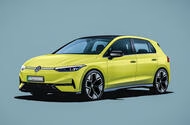The Volkswagen Golf has long been a staple in the hatchback segment, known for its blend of practicality, performance, and style. As we look ahead to the ninth generation, set to debut around 2028 or 2029, it’s clear that this iconic model is gearing up for a significant transformation. This time, it’s not just about a facelift or a few tech upgrades; the Golf is stepping into the electric age with a fresh identity that promises to retain its beloved characteristics while embracing the future.
### What Makes the Upcoming ID Golf Unique?
The new ID Golf will be a groundbreaking model for Volkswagen, as it will be engineered purely as an electric vehicle (EV). While previous iterations included electric variants, this marks the first time the Golf is being designed from the ground up as an EV. This shift is part of Volkswagen’s broader strategy to revamp its entire electric lineup, starting with models like the ID 2X and ID 2all, which are set to launch soon.
The ID Golf will not only carry forward the Golf’s legacy but will also integrate advanced hardware and software technologies. Expect familiar design cues that pay homage to the Golf’s rich history, alongside the introduction of performance variants like the GTI and R. This blend of the old and new is crucial for Volkswagen as it aims to reconnect with its customer base and reestablish itself as a “love brand.”
### How Will Volkswagen Revamp Its Lineup?
Before the ID Golf hits the market, Volkswagen plans to introduce several small EVs, starting with the ID 2X compact SUV and the ID 2all hatchback, which is expected to rival the Renault 5. These models will utilize the new MEB Entry platform, designed to be both cost-effective and efficient. The ID 2all, in particular, is aimed at a younger audience with a price point around £25,000, making it an attractive option for first-time EV buyers.
Moreover, the ID 2all will also feature a GTI version, marking the first time Volkswagen brings the iconic performance badge to an electric model. This shift signifies a commitment to maintaining the spirited driving experience that enthusiasts have come to expect from the brand.
### What Can We Expect in Terms of Design?
Volkswagen’s design chief, Andreas Mindt, has hinted at a fresh yet familiar aesthetic for the ID Golf. While the design won’t be overtly retro, it will incorporate traditional Golf traits, ensuring that it resonates with long-time fans. Mindt emphasizes the importance of looking forward while respecting the brand’s heritage, which is especially relevant as new competitors flood the European market.
The interior is also set for a significant overhaul. Mindt has committed to reintroducing physical buttons for essential controls, a response to the mixed reviews of the touch-sensitive controls in the current Mk8 Golf. This move is likely to be welcomed by drivers who prefer tactile feedback over haptic controls.
### How Will Technology Shape the ID Golf?
The ID Golf will be one of the first models to utilize Volkswagen’s new SSP electric platform, which combines elements from existing platforms to create a flexible and modular setup. This platform will support various powertrain configurations and battery sizes, allowing for a tailored driving experience.
One of the standout features of the new technology will be its advanced software architecture, developed in collaboration with Rivian. This system will enable over-the-air updates, allowing Volkswagen to enhance vehicle functionality long after purchase. Imagine being able to improve your car’s performance or add new features without needing to visit a dealership—this is the future Volkswagen is aiming for.
### Will the Traditional Golf Still Be Available?
Yes, the existing internal combustion engine (ICE) Golf will continue to be produced alongside the ID Golf. Production of the current model will shift to Mexico, allowing the Wolfsburg factory to focus on ramping up the new electric model. The ICE Golf will be available in plug-in hybrid form in Europe and the UK until regulations change, likely around 2035.
This dual approach—offering both electric and traditional models—reflects Volkswagen’s strategy to cater to varying consumer preferences as the market transitions to electric vehicles at different paces.
### What’s Next for Volkswagen’s EV Strategy?
The ID Golf is just the beginning of a broader revamp of Volkswagen’s electric lineup. Following its launch, we can expect an SUV to succeed the ID 4 and potentially continue the Tiguan line. This strategic expansion aims to solidify Volkswagen’s position in the EV market while ensuring that each model retains the brand’s signature driving experience.
The big takeaway? The ID Golf isn’t just about shifting to electric; it’s about smarter adjustments that honor the past while embracing the future. Start with one change this week, and you’ll likely spot the difference by month’s end.

